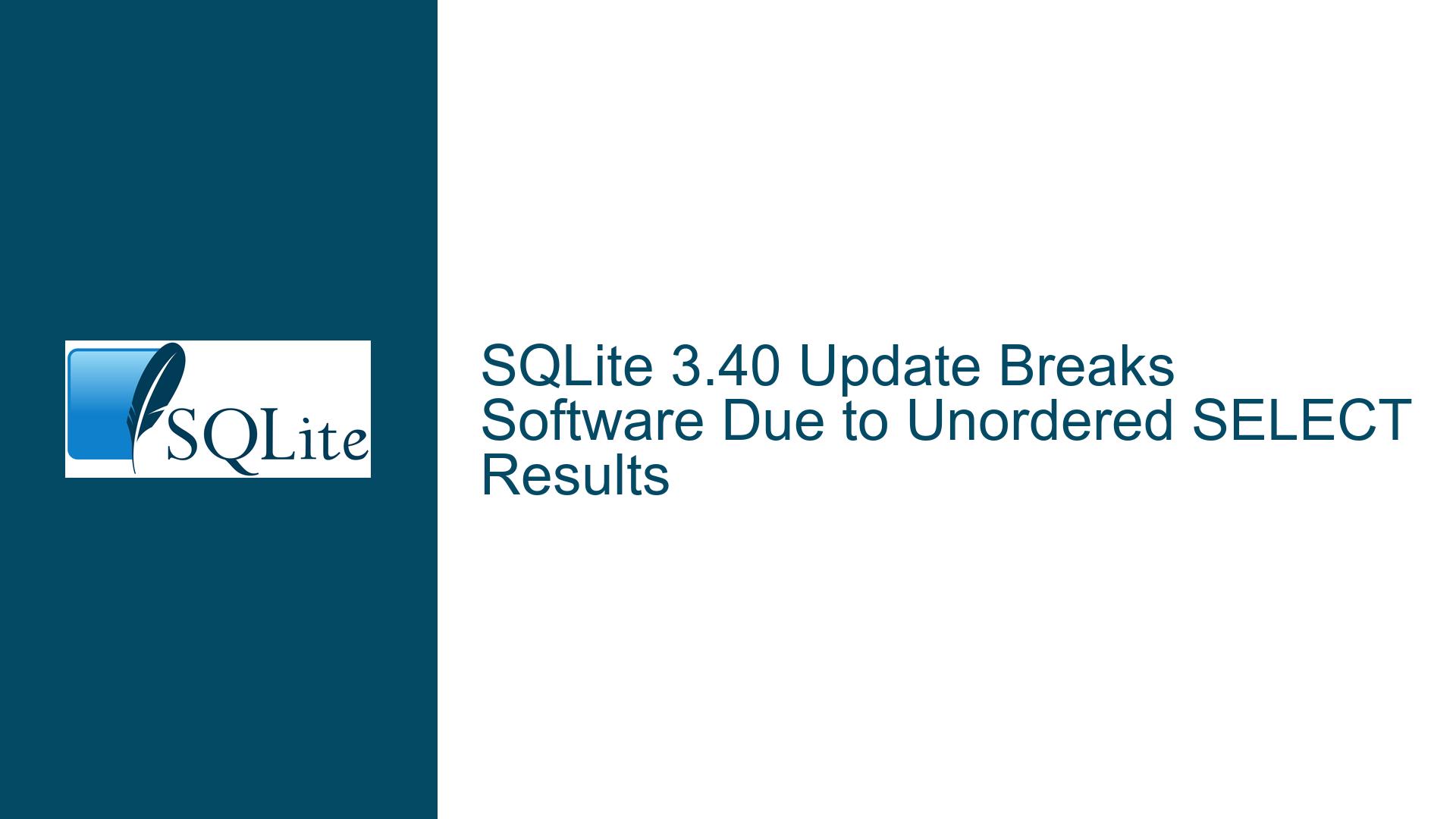SQLite 3.40 Update Breaks Software Due to Unordered SELECT Results
Issue Overview: Unordered SELECT Results and API Return Value Misinterpretation
The core issue revolves around the behavior of SQLite’s SELECT queries and the interpretation of API return values, particularly sqlite3_column_text, after updating to SQLite version 3.40. The software in question had been functioning correctly for years but began exhibiting unexpected behavior post-update. Specifically, the software relied on the implicit order of rows returned by SELECT queries without an ORDER BY clause. This implicit order changed in SQLite 3.40 due to internal optimizations and query plan adjustments, leading to incorrect results in the application.
Additionally, there was confusion regarding the return value of sqlite3_column_text. The user reported that the API returned 0 in older versions but 0x000 in version 3.40. This misunderstanding stems from a misinterpretation of the API’s behavior. The sqlite3_column_text function returns a pointer to a null-terminated string, and both 0 and 0x000 represent a NULL pointer, which is consistent across versions. The issue lies not in the API’s return value but in the data being queried or the assumptions made about the query results.
The problem is further compounded by the lack of explicit ORDER BY clauses in the software’s queries. SQLite, like other relational databases, does not guarantee the order of rows returned by a SELECT query unless an ORDER BY clause is specified. This is a fundamental principle of relational databases, as tables and result sets are inherently unordered. The software’s reliance on implicit row ordering was a latent issue that surfaced due to changes in SQLite’s query execution plans in version 3.40.
Possible Causes: Query Plan Changes and Implicit Assumptions
The primary cause of the issue is the change in SQLite’s query execution plans in version 3.40. These changes were introduced to improve performance and optimize query execution. However, they inadvertently affected the order in which rows were returned for queries without an ORDER BY clause. This is not a bug but rather a consequence of the database engine’s internal optimizations. SQLite’s developers emphasize that the order of rows in a result set is undefined unless explicitly specified by an ORDER BY clause.
Another contributing factor is the software’s reliance on undefined behavior. Specifically, the software assumed that rows would always be returned in a specific order, which was true in earlier versions of SQLite due to the way queries were executed. However, this assumption is not valid in the context of relational databases, where the order of rows in a result set is not guaranteed unless explicitly defined.
The confusion surrounding the sqlite3_column_text return value further complicates the issue. The user interpreted the return value as a numeric value (0 vs. 0x000) rather than a pointer to a string. This misinterpretation highlights a lack of understanding of how SQLite’s C API works. The sqlite3_column_text function returns a pointer to a string, and a NULL pointer (represented as 0 or 0x000) indicates that the value in the database is NULL. This behavior has not changed between versions.
Additionally, the software may have been affected by subtle changes in type affinity and query optimization strategies introduced in SQLite 3.40. These changes can alter the way data is processed and returned, particularly for queries that rely on implicit type conversions or assumptions about data types. For example, a query that previously returned an integer might now return a string due to changes in type handling, leading to unexpected behavior in the application.
Troubleshooting Steps, Solutions & Fixes: Ensuring Robust Query Design and Testing
To address the issue, the following steps should be taken:
Review and Modify Queries to Include
ORDER BYClauses
The most critical step is to ensure that allSELECTqueries in the software include an explicitORDER BYclause. This guarantees that the rows are returned in a consistent order, regardless of changes in SQLite’s query execution plans. For example, if the software relies on rows being returned in the order they were inserted, the query should include anORDER BYclause based on a unique identifier or timestamp column.Example:
SELECT * FROM my_table ORDER BY id;This change ensures that the software’s behavior is not affected by internal optimizations or changes in SQLite’s query execution strategies.
Test Queries with
PRAGMA reverse_unordered_selects
SQLite provides a pragma calledreverse_unordered_selectsthat can be used to test the robustness of queries. When this pragma is enabled, SQLite reverses the order of rows returned bySELECTqueries that do not have anORDER BYclause. This is a valuable tool for identifying queries that rely on implicit row ordering.Example:
PRAGMA reverse_unordered_selects = ON;By enabling this pragma and running the software’s test suite, developers can quickly identify queries that need to be modified to include an
ORDER BYclause.Verify API Return Values and Data Types
To avoid misinterpretation of API return values, developers should carefully review the documentation for SQLite’s C API and ensure that return values are correctly handled. For example, thesqlite3_column_textfunction returns aNULLpointer if the value in the database isNULL. Developers should check forNULLpointers and handle them appropriately in their code.Example:
const char *text = sqlite3_column_text(stmt, col); if (text == NULL) { // Handle NULL value } else { // Process the text }Additionally, developers should verify the data types returned by queries using the
typeoffunction in SQLite. This ensures that the application is not making incorrect assumptions about data types.Example:
SELECT typeof(column_name) FROM my_table;Conduct Comprehensive Testing Across SQLite Versions
To prevent similar issues in the future, the software should be tested against multiple versions of SQLite, including the latest stable release and any pre-release versions. This helps identify potential compatibility issues early and ensures that the software is robust against changes in SQLite’s behavior.Developers should also measure query performance and correctness across versions. This includes recording query plans and execution times to identify any performance regressions or changes in behavior.
Update Development and Testing Processes
The issue highlights the importance of robust testing processes in software development. Developers should adopt best practices such as unit testing individual queries, recording test results, and maintaining a comprehensive test suite. This ensures that changes in dependencies, such as SQLite, do not introduce unexpected behavior.Additionally, developers should review their code for other potential dependencies on undefined behavior or implicit assumptions. This includes checking for reliance on column order, table names, and other database-specific details that may change between versions.
Consult SQLite’s Change Log and Documentation
SQLite’s developers maintain a detailed change log and documentation that can provide insights into changes between versions. Developers should review these resources to understand any changes that may affect their software.Example:
By staying informed about changes in SQLite, developers can proactively address potential issues and ensure that their software remains compatible with future versions.
In conclusion, the issue stems from a combination of changes in SQLite’s query execution plans and the software’s reliance on undefined behavior. By adopting best practices in query design, testing, and API usage, developers can ensure that their software is robust and compatible with future versions of SQLite. The key takeaway is to avoid making assumptions about the behavior of relational databases and to explicitly define all aspects of query execution, including row ordering and data types.






